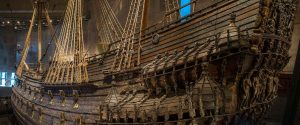On April 24th, 1961, a crowd watched as a massive ship emerged from beneath the waves near a Swedish harbor. This ship was the Vasa, a Swedish military vessel that sank in 1628 and had been sitting on the ocean floor for hundreds of years. Incredibly, the Vasa remained in good condition, with over 90% of its wood and many artifacts remaining, including coins, shoes, and partially-preserved human remains (Laursen 2012). While the rediscovery of the Vasa (Figure 1) presented unprecedented challenges for archaeologists, the successful preservation of the objects and remains on board provides valuable information about life in 17th-century Sweden.
One of the primary factors that allowed the Vasa to be preserved was the cold, brackish water that surrounded it (Robson 2009); the salty water killed microbes or other pests that would have normally eaten the ship apart. As a result, archaeologists could easily observe the ship once it was raised. Somewhere between 17 and 20 skeletons were found on the Vasa, with some even containing fingernails and hair (Larsson 2022). The first step to categorizing the bodies was identifying whether or not they were human (Renfrew 2018, 233-234). Upon investigation, archaeologists found bones from cats, birds, pigs, cows, and fish on the ship, in addition to humans (Figure 2) (Larsson 2022). One of the most notable facts about the human bodies was how short they were, with the tallest person being around 5’9″ (Larsson 2022). This was likely due to their diet, with lack of access to food being common in cold Swedish winters. In contrast to their diet on land, however, there was plenty of food available on the ship. In addition to the varied sources of meat mentioned earlier, the sailors also brought fishing equipment and hunting weapons to replenish their food supply if necessary (Larsson 2022).

Figure 2: Two facial reconstructions of individuals found on the Vasa. Retrieved from https://www.vasamuseet.se.
The archaeological remains aboard the Vasa also provide insight into the culture of the time as they demonstrate the social dynamic aboard the ship. As an example, the bodies of two women and children were found aboard, supporting the notion that Swedish sailors brought their families onto warships when not in battle (Larsson 2022). In addition, many of the bodies bear some of the first documented evidence of work-related injuries, with patterns of damage along bones suggesting that they were crushed or scarred by parts of the ship (Bjarvall 1994). The ages of the sailors recovered also indicate that the men aboard the ship were conscripted into service, with most bodies being somewhere between 18-65 years old.
Overall, the natural and archaeological preservation of the ship combined with bioarchaeological analysis of the humans and animals on board create a vivid depiction of Swedish naval life in the 1600s. The archaeological techniques that have been so successful at revealing the culture inside a ship that sat for centuries under the ocean remain a model for what’s possible in the world of bioarchaeology today.
References
Bjarvall, Katarina. “Skulls Telling Tales of Ancient Mariners : Sweden: Skeletons from a 1628 Shipwreck Give a Glimpse of How the Sailors Looked and Lived. Hollywood’s Portrayals Turn out to Be Pretty Accurate.” Los Angeles Times, 10 July 1994, https://www.latimes.com/archives/la-xpm-1994-07-10-mn-13813-story.html.
Larsson, Martina. Studies of the Skeletons Tell Us about the People Onboard the Vasa. https://www.vasamuseet.se/en/explore/research. Accessed 29 Sept. 2022.
Laursen, Lucas. Vasa’s Curious Imbalance – Archaeology Magazine Archive. Aug. 2012, https://archive.archaeology.org/1207/features/vasa_warship_sweden_stockholm_harbor.html. Accessed 29 Sept. 2022.
Renfrew, Colin, and Paul Bahn. 2018. Archaeology Essentials: Theories, Methods, and Practice. Fourth edition. Thames & Hudson. 2018.
Robson, Sandra. “Ghost Ships of the Baltic.” Nautical Archaeology Quarterly, vol. 36, no. 1. Spring 2009, https://nauticalarch.org/wp-content/uploads/2018/05/36.1-sm.pdf.
Further Reading
Larsson, Martina. The Vasa Museum homepage. https://www.vasamuseet.se/en. Accessed 29 Sept. 2022.
Wheatley, David. Saving the Swedish Warship, VASA. https://www.youtube.com/watch?v=MU1jA9jnNJ8. Accessed 29 Sept. 2022.


What do we know about the history of the Vasa before it sank (i.e. where it was headed, when it was built, how it sank)? How does the archaeology aid in that interpretation?